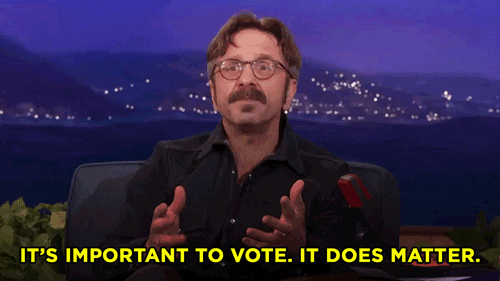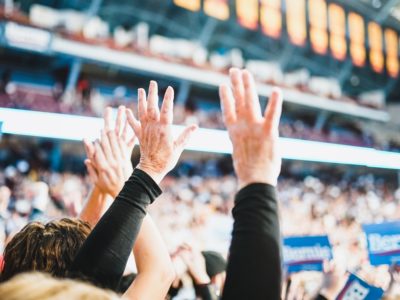With the coronavirus acting as the main character of all of our conversations as of late, we all feel confused and worried as to what will happen next. The chaos happened to align with many college students’ Spring break, which made us sacrifice things we didn’t want to–myself included. But what about the sacrifice of the 2020 primary election, held on March 17th for Florida, Illinois, and Arizona? A lot of my peers became concerned with the election falling on Spring Break, which called for a large push for early voting and vote-by-mail. While these factors give people a greater opportunity and accessibility to voting so we don’t all have to rely on a single day, we still have a long way to go to make voting easier for everyone.
But did the coronavirus and Spring Break actually harm young voter turnout?
Voter turnout matters immensely, arguably the most for young people, because we have the opportunity to have a say in who represents us and make decisions that affect our well-being. Young people account for a substantial amount of the voting population. We literally have the power to sway elections, our population offers diversity and the fact that polices affect our future the most means that you should absolutely care. So in that vein, we investigate recent turnout for the presidential primary.
Young Voter Turnout Has Potential to Grow

The good news–according to the news publication Vox, voter turnout in Florida and Arizona actually went up from the numbers in the 2016 primary election. They also claim that “In Illinois, 39 percent of voters were under 44, compared to the 61 percent that was age 45 and older.” It comes as a surprise to no one that young people historically don’t show up to vote. Many experts have theorized why and point to various reasons. To name some, the voting system setup makes it extremely difficult to cast a vote, people don’t recognize that these policies affect them individually, candidates don’t campaign for the youth vote, or we haven’t been properly taught about elections and the government so we don’t feel comfortable voting. Early voting and voting-by-mail help some of the problems in terms of accessibility to those states who offer it, but it doesn’t solve the whole problem in the grand scheme of things.
However, with movements by young people encouraging youth voter turnout, our age group has done a lot in the past to fight this. For example, in the past few years, the Parkland shooting survivors have done unbelievable work in rallying people behind anti-gun violence and fighting for change from policymakers. Malala Yousafzai has a deeply inspiring story of activism for women’s and girl’s education. People like these change our conceptions of what young people are really capable of. In fact, young people (18 to 24-year-olds) drove voter turnout increases in the 2018 midterm elections. With this movement surrounding the youth and the fact that policies will affect this age group the most, our government should work towards making elections as easy as possible–and that means not holding them over spring break. Many people register to vote once they go to college or change their voting address to where they live in their college city.
Even if they registered in their hometown, not everyone goes home during spring break and student’s academic and personal plans could make voting the last thing on their minds. The problem lies in the inconsistency of daily college life that comes with a break that makes voter turnout so uncertain. “I am registered to vote in Tallahassee so I participated in early voting,” said Florida State University senior Madison Stuart. “That was when people were just starting to get concerned about COVID-19, so it was scary to even vote in-person then. I really felt for those people who had to make a decision on actual voting day.” Hypothetically, voting-by-mail can solve this, but lack of education and resources also hinder college students and other citizens from this option.
COVID-19 Only Complicated Difficulties in Voting

On top of this, the 2020 election happened about five days after many colleges canceled classes due to the coronavirus. The country urged us to practice social distancing and avoid going to public places, yet expected us to show up to vote on Tuesday. This brings into question our current simultaneous responsibilities to the collective public health to avoid crowded spaces and to our government to vote in elections.
In all honesty, we could accost low in-person voter turnout to things other than the pandemic and spring break–like early voting and voting-by-mail. “I was lucky enough to have voted early so I can feel good about exercising my right to vote without having to jeopardize my health. I think it wasn’t fair for Florida and other states to hold a crucial election during all of this,” said University of Florida freshman Emma Thomas.
However, we can’t know for sure, and one could safely say that these factors played some kind of role in turnout. “I feel that the state of Florida didn’t take the needs of its citizens into account when they held the primary. It was more important to keep things appearing as normal than to ensure every citizen could perform their civic duty,” said Florida State senior Senior Madison Walsh. We should critically engage with these decisions by our government and question what we should do to make it as easy as possible for every person to cast their ballot.
You Can Take Action To Ensure Your–and Others’–Right to Vote

What now? The coronavirus in this past election forced people to make a hard decision between their health and their right to vote, which no one should have to make. One major action you can take to help with this problem in the future includes registering to vote-by-mail and encouraging your friends to do so too. This way, you don’t have to physically go anywhere if this pandemic continues to the November election (and we have no idea what our government will do if it comes to that). If we can safely operate normally come November and you want to vote in-person, you can always bring in your mailing ballot and authorities will let you vote in the voting booth. Lastly and most importantly, encourage your friends and family to vote, and volunteer for organizations that register young voters or fight for policy change that you care about. Just, please—even though obstacles exist that make it difficult— vote.



















